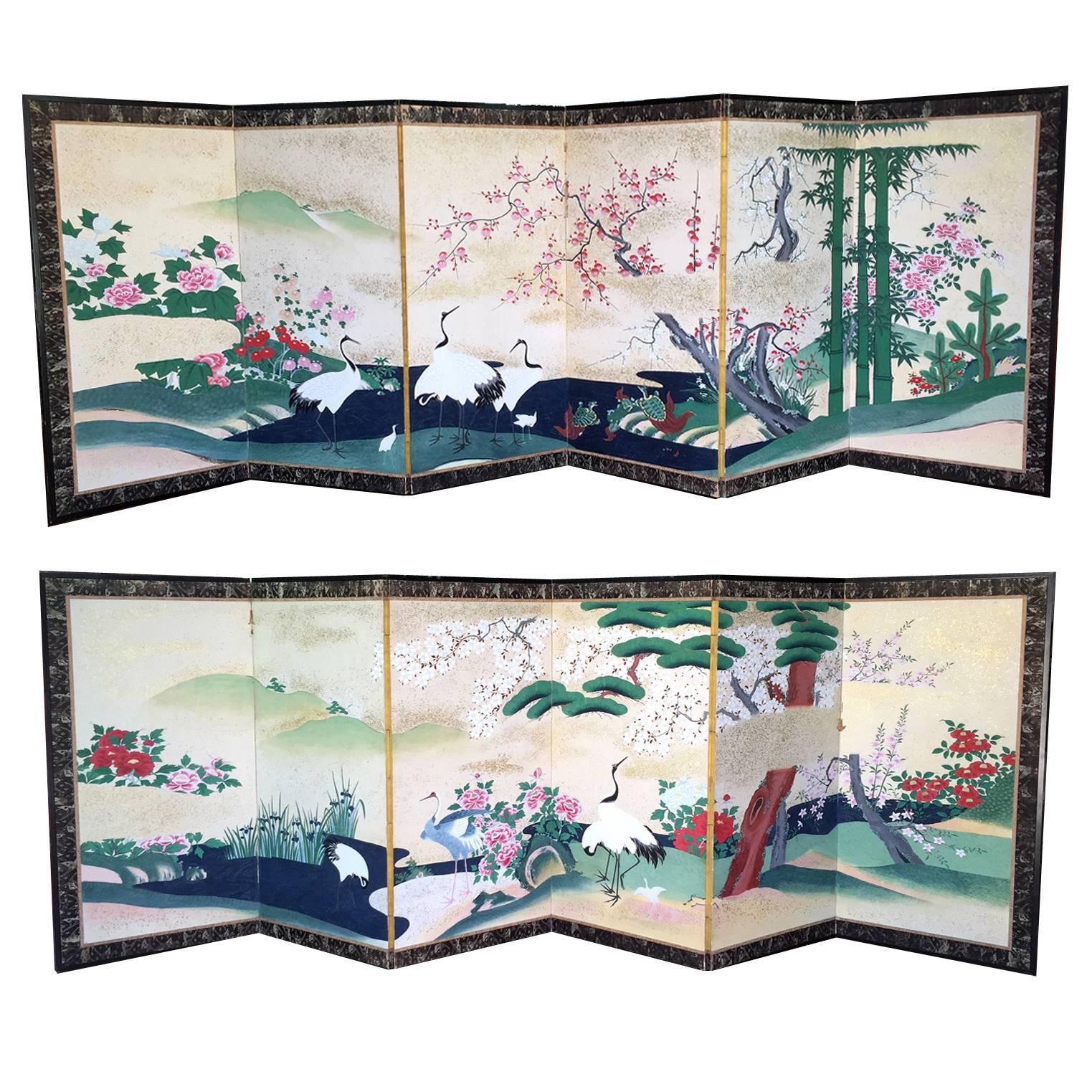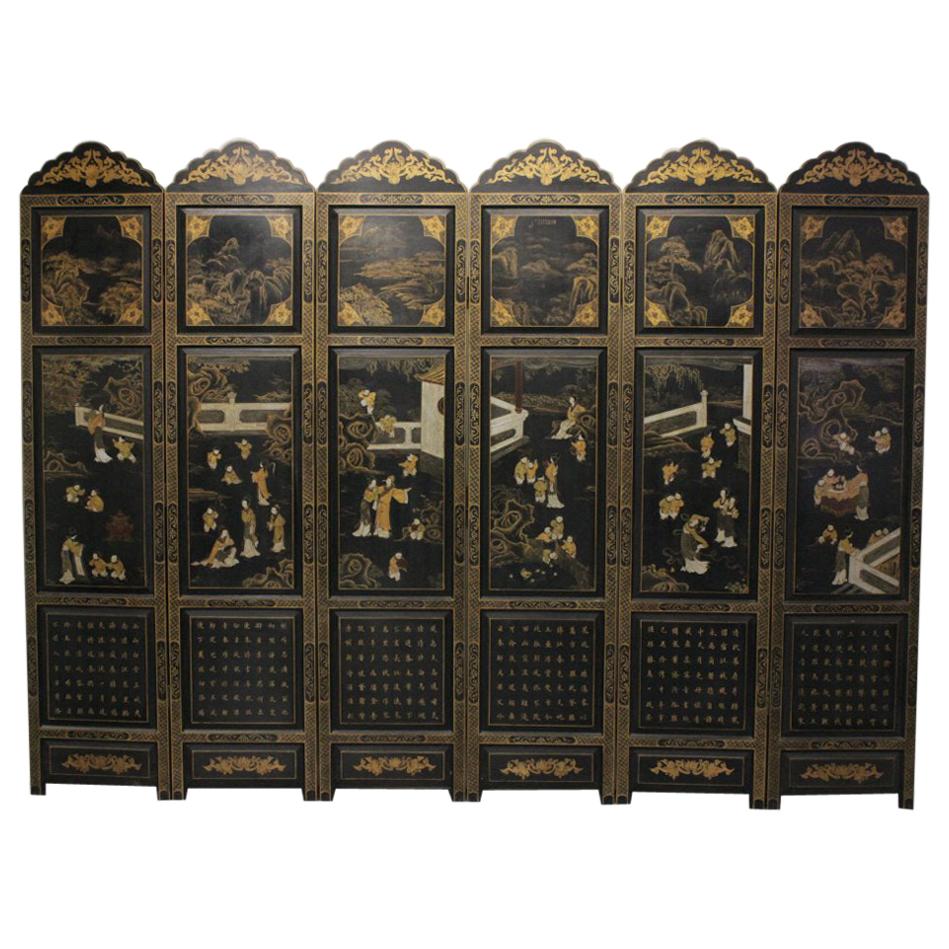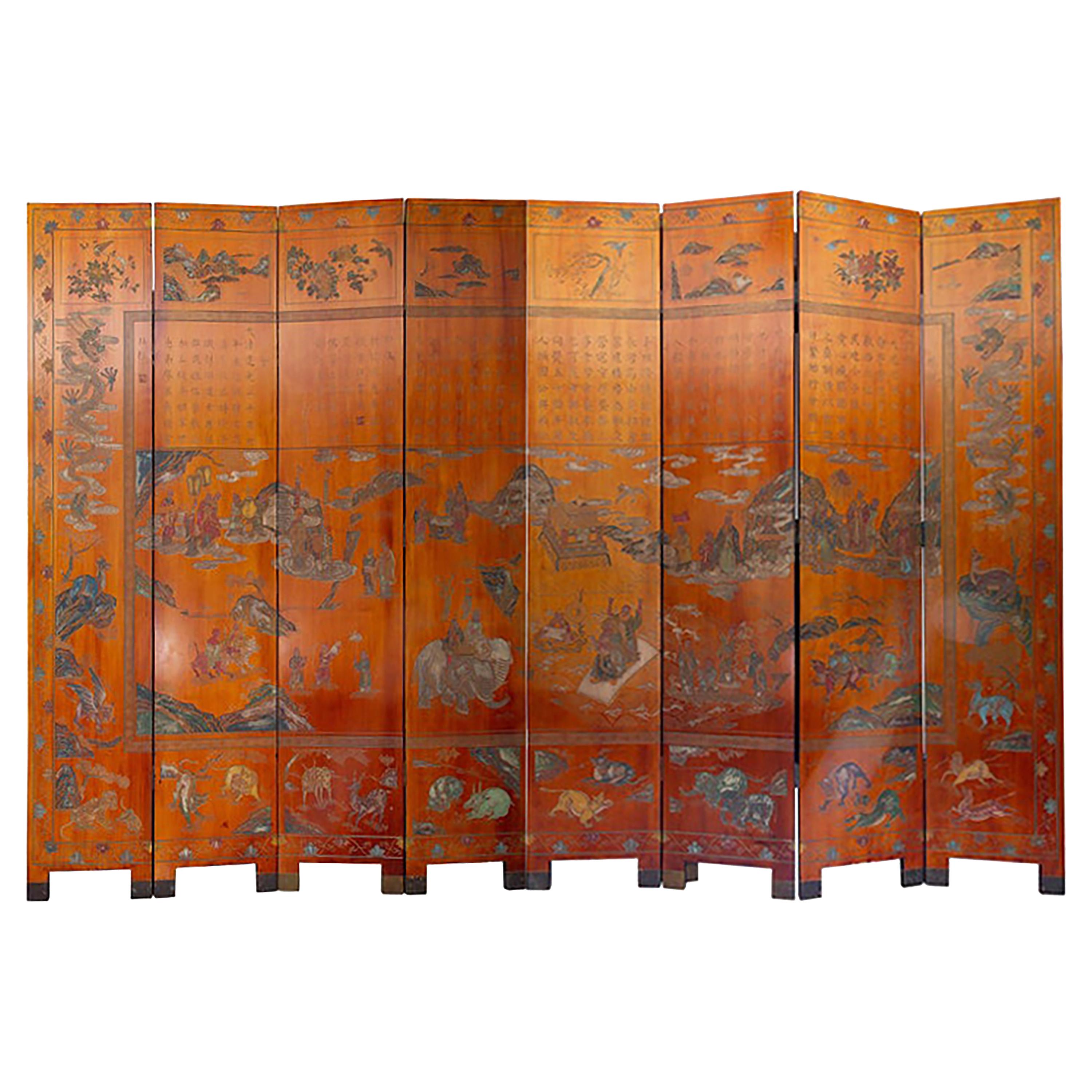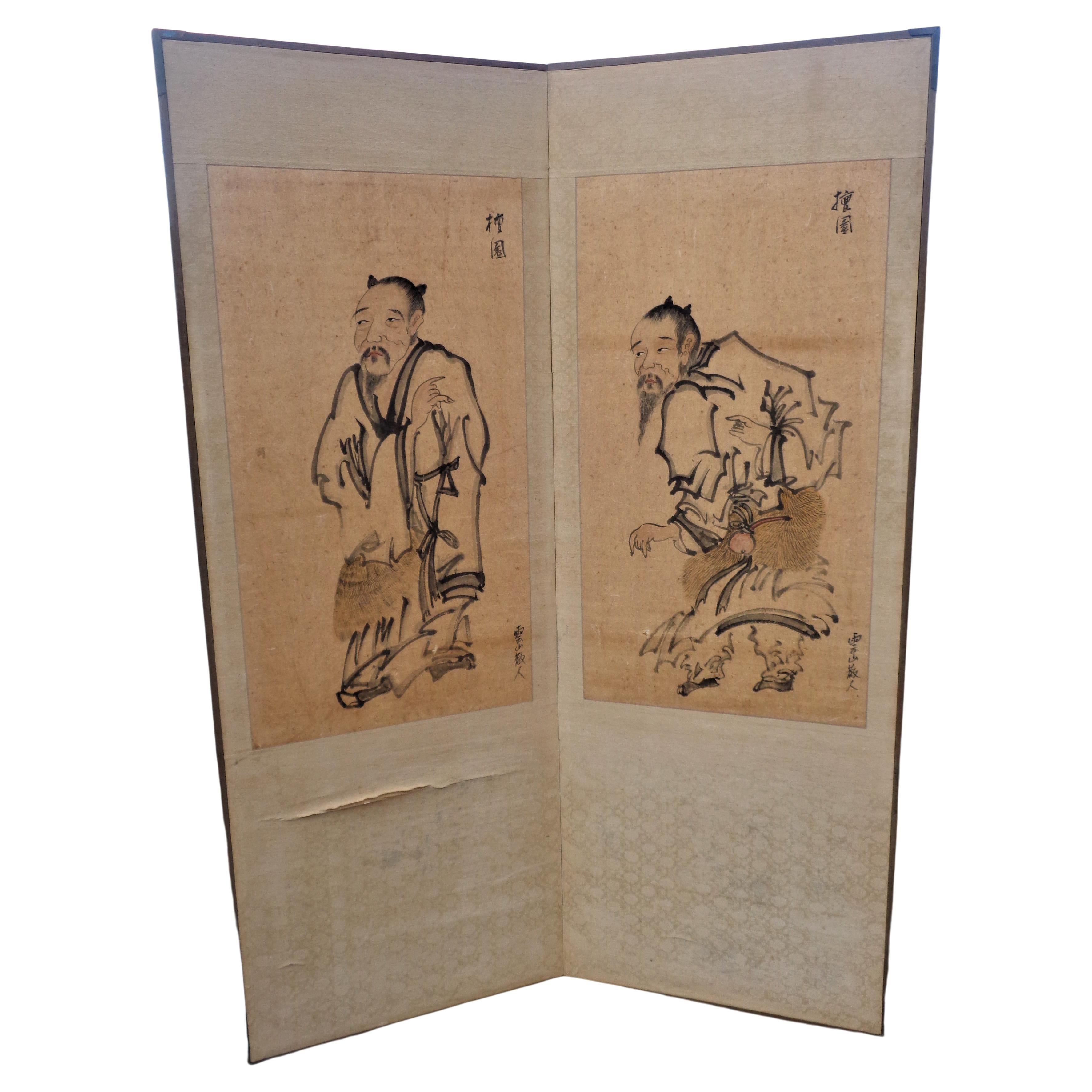Items Similar to Japanese Screen "the Song of Everlasting Sorrow"
Want more images or videos?
Request additional images or videos from the seller
1 of 10
Japanese Screen "the Song of Everlasting Sorrow"
About the Item
Six-panels screen depicting the exit from the city of a Chinese emperor on horseback and his concubine in a luxurious palanquin.
It may be a scene illustrating the poem The Song of Everlasting Sorrow (Chang hen ge, ???) written by Bai Juyi (772-846), which recounts the tragic love story between the emperor Ming Huang (also known as Tang Xuanzong, 685-762) and his favorite concubine, the beautiful Yang Guifei (719-756). His excessive love led to intrigues at court and unrest in the empire. A rebellion in 755 forced the emperor to flee the capital. The uprising led by the general An Lushan (705-757) accused Yang Guifei of the emperor’s negligence and was executed the following year. The emperor abdicated shortly afterwards, setting the decline of the Tang dynasty.
This story became a popular theme for the Kanô school painters from the Momoyama period (1573-1615) to the early Edo period (1615-1868). This long-lasting popularity in Japanese visual and literary arts reflects a strong emotional identification with the love, death and longing themes, and the persistent idea of Tang Dynasty China as a cultural golden age. Moreover, the poem served as source of inspiration for the famous novel The Tale of Genji (c. 1010) written by Murasaki Shikibu (c. 973 – 1014/1025).
Signed Kanô Dôgen (????, 1643-1703). He was the second son of Kanô Sôsen (????). He founded an independent studio as an official omote eshi (external painter) of the shgunate in Asakusa Saryumachi, a district in current Tokyo. He also known as Ikinobu, Kuninobu or Kumenosuke.
He belonged to the Kanô school, one of the most famous Japanese schools of painting. This was stablished in the late Muromachi period, which means around the middle of the 15th century by Kanô Masanobu (????, 1434? - 1530?). This family artists workshop combined Muromachi period and Chinese-derived ink painting techniques with decorative and traditional Japanese elements. During the Edo period (1603-1868), they were the official painters of the Tokugawa shogunate. The subjects of literature and more broadly Chinese culture are very popular with the Kanô school.
The British Museum holds a hanging scroll by the artist: Kanô Dôgen, Hanging scroll. Bird and plum blossom, late 17th century, 38.5 x 12.4 in., inv. 1881,1210,0.768.
Kanô Dôgen (1643-1703)
Japan - Edo period (1603 - 1868) - second half of the 17th century
Height: 186 cm – six-panels – width 480 cm (total).
- Dimensions:Height: 186 in (472.44 cm)Width: 480 in (1,219.2 cm)Depth: 30 in (76.2 cm)
- Materials and Techniques:
- Place of Origin:
- Period:Late 17th Century
- Date of Manufacture:1603-1868
- Condition:Repaired.
- Seller Location:PARIS, FR
- Reference Number:
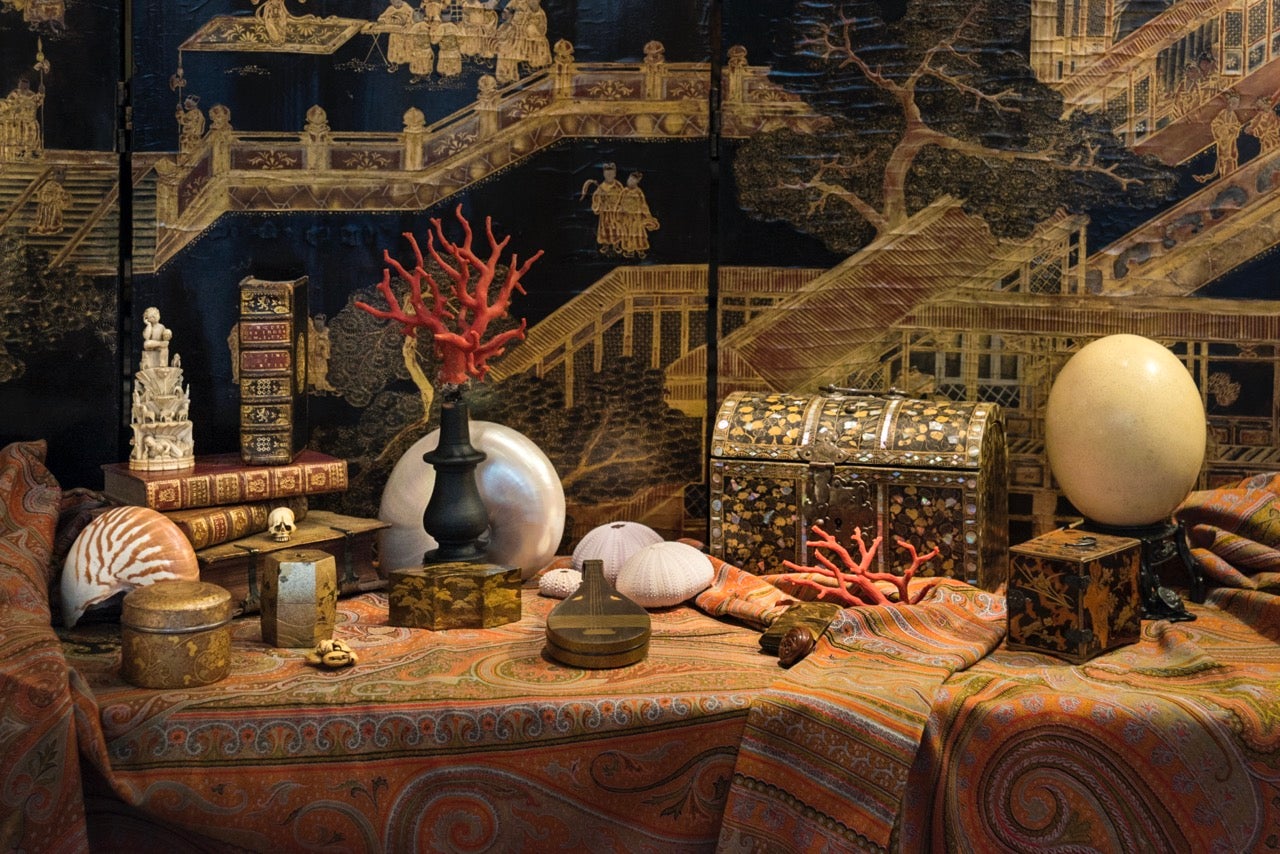
About the Seller
No Reviews Yet
Vetted Seller
These experienced sellers undergo a comprehensive evaluation by our team of in-house experts.
Established in 2013
1stDibs seller since 2023
- ShippingRetrieving quote...Ships From: PARIS, France
- Return PolicyA return for this item may be initiated within 7 days of delivery.
More From This SellerView All
- Japanese Peanuts NetsukeLocated in PARIS, FRWood netsuke of three peanuts. A naturalistic grouping, dark stained. An ivory plug may bear a highly stylised signature. Provenance : Arlette Katchen, Paris. Japan, 20th centu...Category
Mid-20th Century Japanese Sculptures and Carvings
MaterialsWood
- Japanese Black and Gold Lacquer Kaioke Boxes 'Hokaibako'Located in PARIS, FRTwo big eight-sided kaioke boxes in black lacquer, decorated with mon and maple leaves in golden lacquer. These are usually octagonal boxes containing the painted shells used in ...Category
Antique Late 19th Century Japanese Lacquer
MaterialsLacquer
- Pair of Japanese Abumi StirrupsLocated in PARIS, FRPair of stamped brass stirrups decorated with Hashizuka, Ito and Manabe Mons. Japan - Edo (1615-1868), 18th century. Height: 10.24 in. (26 cm), length: 12.6 in. (32 cm), width 4.72 in. (12 cm) As in Western culture, the culture Japanese stirrups were part of traditional accessories...Category
Antique Late 18th Century Japanese Metalwork
MaterialsBrass
- Pair of Japanese Bronze Grasshopper VasesLocated in PARIS, FRInsects (mushi) occupy an important place in Japanese culture. Hunting for insects is a popular pastime, especially among children. Using plastic nets and cages, they catch cicadas and beetles to observe them. Between 1830 and 1832, Hokusai composed an untitled series of ten large horizontal prints...Category
Antique Late 19th Century Japanese Metalwork
MaterialsBronze
- Japanese Bronze Group of Mice, Pumpkin and PomegranateLocated in PARIS, FRPolychrome bronze of a group of mice around a pumpkin and a pomegranate. The five mice have a dark brown patina, while the hollowed-out gourd is dark brown and the split pomegranate ...Category
Antique Late 19th Century Japanese Metalwork
MaterialsBronze
- Japanese Bronze KappaLocated in PARIS, FRDark brown patina bronze figure of a standing kappa with its right leg leaning on a cucumber. The figure is put on four-legged rattan-like bronze stand. The kappa (??) is a aquati...Category
Antique Late 19th Century Japanese Metalwork
MaterialsBronze
You May Also Like
- Pair of Rare Antique Japanese Folding Screens with ProvenanceLocated in Atlanta, GAAn amazing pair of matching antique Japanese folding screen predating 1812-1813, most likely from Kano School. Six panels each depict C...Category
Antique 1810s Japanese Japonisme Paintings and Screens
MaterialsBrass
- Chinese Lacquered Six Panel ScreenLocated in Cypress, CAImpressive Chinese lacquered and parcel gilt six panel screen. Mid 20th century Each lacquered and parcel gilt decorated panel is separated into fo...Category
Mid-20th Century Chinese Paintings and Screens
MaterialsWood
- Chinese Hardwood and Nephrite ScreenLocated in London, GBThis screen, comprised of four sections and formed from Chinese hardwood and nephrite, is a beautiful piece of Chinese design—the dark lustre of the nephrite accenting the warm tones...Category
20th Century Chinese Paintings and Screens
MaterialsJade
- Chinese Export Eight Panel Screen.Located in WEST PALM BEACH, FLThis is a lovely Chinese export hand painted screen, with an unusual sienna back ground, carved and painted overall with figures and animals.Category
Early 20th Century Chinese Chinese Export Paintings and Screens
MaterialsWood
- Japanese Buddhist Teaching PaintingLocated in Greenwich, CTJapanese Buddhist teaching painting, set of four paintings with 24 Buddhist stories with Japanese written characters in each story on one screen. Provenance: Purchased from Christie's South Kensington...Category
Antique 1820s Japanese Edo Paintings and Screens
MaterialsPaper
- Antique 19th Century Chinese Ancestral Scroll Paintings Two Panel Folding ScreenLocated in Rochester, NYAntique Chinese artist signed ancestral scholar figure scroll paintings incorporated into a two panel grass cloth backed folding screen. The scroll paintings are matted with decorated Chinese silk...Category
Antique Mid-19th Century Chinese Qing Paintings and Screens
MaterialsGrasscloth, Wood, Paper, Fabric, Silk
Recently Viewed
View AllMore Ways To Browse
The Emperor
Antique Led
The Wood Of Arts And Antique Furniture
Japanese Golden
One Panel Screen
Japanese Emperor
Emperor Japan
Hanging Art Japanese
Japan Ink Wood
Antique Novels
Antique Novel
Antique Hanging Scroll
Antique Decorative Screens
Japanese Painting With Birds
Decorative Screen Panel
Japanese Silk Screen Painting
Japanese Hanging
Antique Poem
